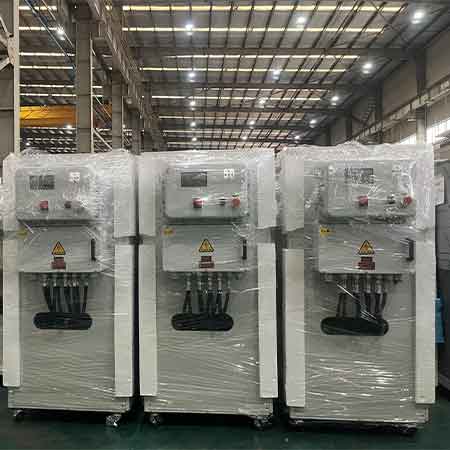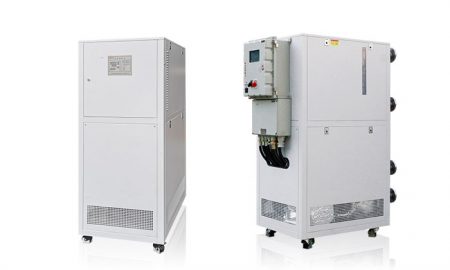Oil Circulation Heater
Contattateci oggi stesso per la soluzione di controllo della temperatura perfetta
Oil circulation heater is a fluid heater that uses the principle of a circulation pump to transfer stored heat energy to the oil that needs to be heated, thereby heating the oil. It is widely used in industrial production processes, effectively improving production efficiency and quality.
The use of this device is very simple. First, add the oil to be heated into the oil storage tank in the device, and then start the circulation pump to allow the oil to flow through the heating pipe. The heating pipe is filled with heating medium. Through the heating effect of the heating medium, the heat energy in the pipe is transferred to the oil flowing through the pipe, so that the temperature of the oil gradually increases.
When using an oil circulation heater, the heating temperature also needs to be adjusted according to actual needs. Depending on the type of heating medium in the heating pipe, the heating temperature will also be different. For example, the heating temperature of commonly used hot water circulation heating devices is generally above 60°C.
You also need to pay attention to safety issues when using oil circulation heaters. Before starting the circulation pump, it is necessary to ensure that there is sufficient oil in the oil storage tank, and all pipe connections in the device need to be checked to see if they are tight and sealed. In addition, it is necessary to regularly check whether the heating medium in the heating pipe needs to be replaced to ensure the normal use of the device.

The oil circulation heater mainly consists of the following parts:
1. Thermal oil heater: The thermal oil heater is a device that heats thermal oil to the required temperature. It usually consists of a burner, combustion chamber, flue gas exhaust system and heat exchanger. The burner burns fuel to generate heat, and the heat is transferred to the thermal oil through the heat exchanger to heat it up.
2. Thermal oil circulation pump: The thermal oil circulation pump is responsible for extracting the heated thermal oil from the heater and circulating it through the pipeline system to the equipment that needs to be heated. Circulation pumps are usually driven by electric motors and can provide sufficient flow and pressure to ensure the circulation of thermal oil in the system.
3. Piping system: The piping system is the delivery channel in the oil circulation heater, which is used to connect the heater, circulation pump and heating equipment. It is usually constructed of high-temperature-resistant steel or stainless steel pipes, insulated with insulation to reduce heat loss.
4. Heating equipment: Heating equipment is the terminal equipment in the oil circulation heater, which is used to transfer heat transfer oil to process equipment or production equipment that requires heating. These equipment can be hot blast stoves, heat exchangers, reactors, dryers, etc., which can heat process materials or media through heat transfer of thermal oil.
5. Control system: The control system is used to monitor and control the operation of the oil circulation heater. It usually includes temperature sensors, pressure sensors, flow meters and control valves to monitor and adjust the temperature, pressure and flow of thermal oil in real time to ensure the safe and stable operation of the system.
The oil circulation heater transfers heat from the heater to the heating equipment by circulating thermal oil to heat process materials or media. It has the advantages of high heat transfer efficiency, high temperature control accuracy, and flexible operation, and is widely used in many industrial fields.

In addition to the main components mentioned above, an oil circulation heater may also include some of the following auxiliary equipment and functions:
1. Expansion tank: The thermal oil will expand and contract due to temperature changes during the heating process. In order to compensate for the volume change of the thermal oil, an expansion tank is usually installed in the system. The expansion tank can absorb the expansion of the thermal oil and maintain the stability of the system.
2. Filter: In order to ensure the cleanliness and fluidity of the thermal oil, a filter is usually installed in the system. Filters remove impurities and particles from thermal fluid, preventing them from clogging pipes and damaging equipment.
3. Exhaust device: During the operation of the system, gas may be generated in the heat transfer oil. In order to avoid system failure caused by gas accumulation, an exhaust device is usually installed in the system. The exhaust device can discharge the gas out of the system and maintain the normal circulation of the thermal oil.
4. Temperature controller: The temperature controller in the oil circulation heater is used to monitor and adjust the temperature of the heat transfer oil. It can automatically control the combustion of the heater and the operation of the circulation pump according to the set temperature range to keep the temperature of the heat transfer oil stable.
5. Safety valve and alarm device: In order to ensure the safe operation of the system, oil circulation heaters are usually equipped with safety valves and alarm devices. The safety valve can automatically release pressure when the system pressure exceeds the set value to avoid rupture of equipment and pipelines. The alarm device can monitor the temperature, pressure, liquid level and other parameters of the system. Once it exceeds the set range, it will sound an alarm to remind the operator to take corresponding measures.
To sum up, the oil circulation heater is a complex system consisting of multiple components and auxiliary equipment, which achieves heat transfer and heating by circulating thermal oil. Different application requirements may have some differences, but the overall goal is to ensure the safe, stable and efficient operation of the system.
E-mail: info@lneya.com ID WeChat: +8615251628237 WhatsApp: +86 17851209193

Circolatori di riscaldamento
Intervallo di controllo della temperatura: Da +50°C a +300°C
Nota: la serie UC può controllare la temperatura del mezzo di trasferimento del calore. La serie UST può controllare non solo la temperatura del mezzo di trasferimento del calore, ma anche quella del materiale di reazione.
| Intervallo di temperatura | +50°C ~ +170°C (serie UC) | +50°C ~ +300°C (serie UC) | +50°C ~ +300°C (serie UST) | ||||||
| Capacità di riscaldamento | 5,5 ~ 15kW | 3,5 ~ 130kW | 3,5 ~ 95kW | ||||||
| Nota: qualsiasi intervallo di temperatura da -150℃ a +350℃ e qualsiasi capacità di raffreddamento possono essere personalizzati. | |||||||||
 LNEYA
LNEYA
 简体中文
简体中文

















































































